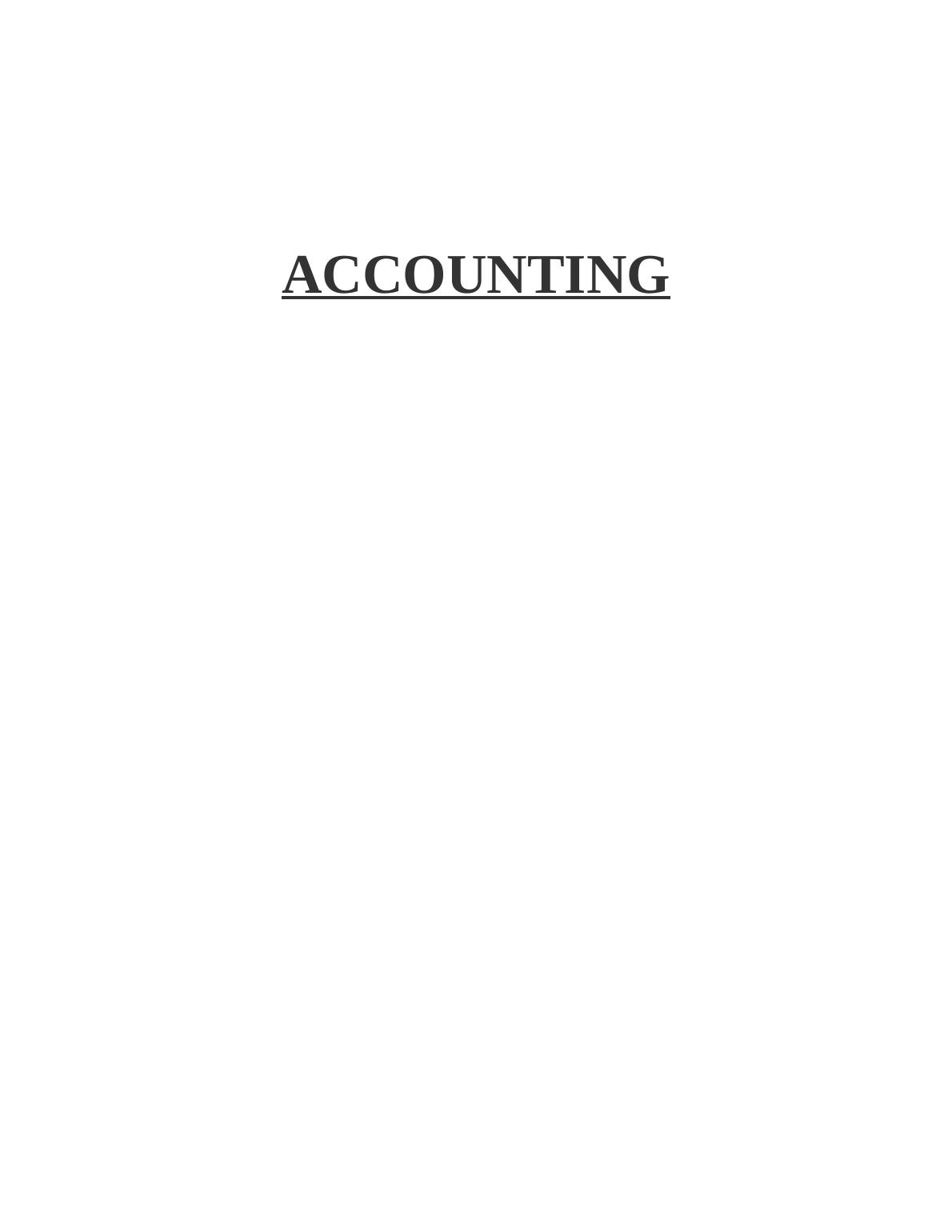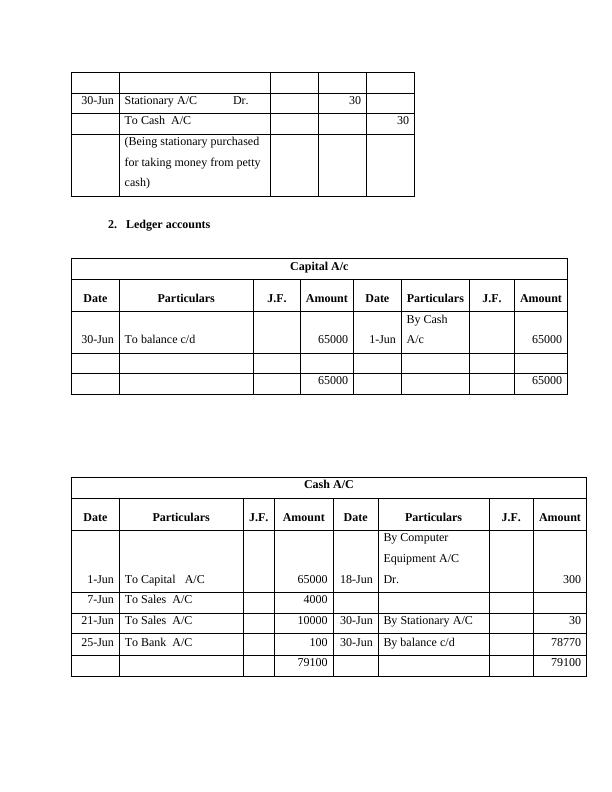Accounting: Business Transactions, Financial Statements, Fundamental Principles
Added on 2022-11-25
26 Pages4285 Words155 Views
ACCOUNTING

TABLE OF CONTENTS
INTRODUCTION.......................................................................................................................................3
SCENARIO 1..............................................................................................................................................3
Question 1...............................................................................................................................................3
Question 2...............................................................................................................................................4
Question 3.............................................................................................................................................11
Question 4.............................................................................................................................................12
Question 5.............................................................................................................................................13
Question 6.............................................................................................................................................15
Question 7.............................................................................................................................................16
SCENARIO 2............................................................................................................................................17
Question 1.............................................................................................................................................17
Question 2.............................................................................................................................................18
Question 3.............................................................................................................................................19
Question 4.............................................................................................................................................19
Question 5.............................................................................................................................................21
CONCLUSION.........................................................................................................................................23
REFERENCES..........................................................................................................................................24
INTRODUCTION.......................................................................................................................................3
SCENARIO 1..............................................................................................................................................3
Question 1...............................................................................................................................................3
Question 2...............................................................................................................................................4
Question 3.............................................................................................................................................11
Question 4.............................................................................................................................................12
Question 5.............................................................................................................................................13
Question 6.............................................................................................................................................15
Question 7.............................................................................................................................................16
SCENARIO 2............................................................................................................................................17
Question 1.............................................................................................................................................17
Question 2.............................................................................................................................................18
Question 3.............................................................................................................................................19
Question 4.............................................................................................................................................19
Question 5.............................................................................................................................................21
CONCLUSION.........................................................................................................................................23
REFERENCES..........................................................................................................................................24

INTRODUCTION
Financial Accounting (FA) is procedure of utilizing monetary information through
making summarization of related data to gain deeper insights about firm’s liquidity position. In
present era, it is crucial for company to have efficient FA procedure to derive significant
information to get competitive advantages. The current study is based on providing important
regarding concepts like business transaction, accounting principles, journal entries, ledger, trial
balance, financial reports & statements, cash flow, bank reconciliation, control & suspense
account, etc. To get deeper insights about the same related calculations will be provided in the
systematic format .
SCENARIO 1
Question 1
Business Transaction is related with an economic activity which is recorded in
accounting system. There are different forms of business transaction that are important to
recorded for analyzing, evaluating and controlling monetary position. In order to have
sustainability company conducts different kinds of transaction that are related to internal
and external practices. It includes, cash & credit purchase, sales, raising funds,
expenditure regarding interest, tax, salaries, etc. For having accurate estimation of
company position it becomes essential for organization to record all types of business
transactions.
Single entry presents one sided organizational picture that is unable to track all
transactions as it records business activities partially. On the other side, double entry
system is based on fundamental accounting principle that helps company take all aspects
transactions into consideration (Siagian, 2020). It becomes difficult to identify the errors
through single entry system as compared to double. Assessing financial position with
help of double entry book keeping system it become convenient.
Trial Balance (TB) is combined worksheet that comprises all ledgers’ balances which is
done once the reporting period. For ensuring book keeping accuracy through equalizing
debit & credit balance TB is prepared. It is utilized for various purposes such as
preparation of financial statements, identifying & rectifying errors, formulation of audit
Financial Accounting (FA) is procedure of utilizing monetary information through
making summarization of related data to gain deeper insights about firm’s liquidity position. In
present era, it is crucial for company to have efficient FA procedure to derive significant
information to get competitive advantages. The current study is based on providing important
regarding concepts like business transaction, accounting principles, journal entries, ledger, trial
balance, financial reports & statements, cash flow, bank reconciliation, control & suspense
account, etc. To get deeper insights about the same related calculations will be provided in the
systematic format .
SCENARIO 1
Question 1
Business Transaction is related with an economic activity which is recorded in
accounting system. There are different forms of business transaction that are important to
recorded for analyzing, evaluating and controlling monetary position. In order to have
sustainability company conducts different kinds of transaction that are related to internal
and external practices. It includes, cash & credit purchase, sales, raising funds,
expenditure regarding interest, tax, salaries, etc. For having accurate estimation of
company position it becomes essential for organization to record all types of business
transactions.
Single entry presents one sided organizational picture that is unable to track all
transactions as it records business activities partially. On the other side, double entry
system is based on fundamental accounting principle that helps company take all aspects
transactions into consideration (Siagian, 2020). It becomes difficult to identify the errors
through single entry system as compared to double. Assessing financial position with
help of double entry book keeping system it become convenient.
Trial Balance (TB) is combined worksheet that comprises all ledgers’ balances which is
done once the reporting period. For ensuring book keeping accuracy through equalizing
debit & credit balance TB is prepared. It is utilized for various purposes such as
preparation of financial statements, identifying & rectifying errors, formulation of audit

reports, strategic decision making, comparative analysis, etc. These all provides
assistance in assessing arithmetical accuracy of organization.
Question 2
1. Journal Entries for the month of June 2016
Date Particulars L.F Debit Credit
1-Jun Cash A/C Dr. 65000
To Capital A/C 65000
(Being capital invested for
starting company)
2-Jun Purchase A/C Dr. 8000
To Trade payables A/C 8000
(Being goods purchased on
credit)
7-Jun Cash A/C Dr. 4000
To Sales A/C 4000
(Being goods sold for cash)
8-Jun
Trade payables A/C
Dr. 4000
To Bank A/C 4000
(Being cheque issued to pay
creditors)
14-Jun
Prepaid Insurance A/C
Dr. 75
To Bank A/C 75
(Being prepaid insurance
expenses paid )
assistance in assessing arithmetical accuracy of organization.
Question 2
1. Journal Entries for the month of June 2016
Date Particulars L.F Debit Credit
1-Jun Cash A/C Dr. 65000
To Capital A/C 65000
(Being capital invested for
starting company)
2-Jun Purchase A/C Dr. 8000
To Trade payables A/C 8000
(Being goods purchased on
credit)
7-Jun Cash A/C Dr. 4000
To Sales A/C 4000
(Being goods sold for cash)
8-Jun
Trade payables A/C
Dr. 4000
To Bank A/C 4000
(Being cheque issued to pay
creditors)
14-Jun
Prepaid Insurance A/C
Dr. 75
To Bank A/C 75
(Being prepaid insurance
expenses paid )

15-Jun
Trade receivables A/C
Dr. 12000
To Sales A/C 12000
(Being goods sold on credit)
16-Jun Purchase A/C Dr. 10000
To Trade payables A/C 10000
(Being goods purchased on
credit)
18-Jun
Computer Equipment A/C
Dr. 300
To Cash A/C 300
(Being computer equipment
purchased by paying in
cash)
20-Jun Prepaid rent A/C Dr. 150
To Bank A/C 150
(Being prepaid rent paid )
21-Jun Cash A/C Dr. 10000
To Sales A/C 10000
(Being goods sold for cash)
25-Jun Cash A/C Dr. 100
To Bank A/C 100
(Being amount withdrawn
from bank for keeping it into
petty cash)
Trade receivables A/C
Dr. 12000
To Sales A/C 12000
(Being goods sold on credit)
16-Jun Purchase A/C Dr. 10000
To Trade payables A/C 10000
(Being goods purchased on
credit)
18-Jun
Computer Equipment A/C
Dr. 300
To Cash A/C 300
(Being computer equipment
purchased by paying in
cash)
20-Jun Prepaid rent A/C Dr. 150
To Bank A/C 150
(Being prepaid rent paid )
21-Jun Cash A/C Dr. 10000
To Sales A/C 10000
(Being goods sold for cash)
25-Jun Cash A/C Dr. 100
To Bank A/C 100
(Being amount withdrawn
from bank for keeping it into
petty cash)

30-Jun Stationary A/C Dr. 30
To Cash A/C 30
(Being stationary purchased
for taking money from petty
cash)
2. Ledger accounts
Capital A/c
Date Particulars J.F. Amount Date Particulars J.F. Amount
30-Jun To balance c/d 65000 1-Jun
By Cash
A/c 65000
65000 65000
Cash A/C
Date Particulars J.F. Amount Date Particulars J.F. Amount
1-Jun To Capital A/C 65000 18-Jun
By Computer
Equipment A/C
Dr. 300
7-Jun To Sales A/C 4000
21-Jun To Sales A/C 10000 30-Jun By Stationary A/C 30
25-Jun To Bank A/C 100 30-Jun By balance c/d 78770
79100 79100
To Cash A/C 30
(Being stationary purchased
for taking money from petty
cash)
2. Ledger accounts
Capital A/c
Date Particulars J.F. Amount Date Particulars J.F. Amount
30-Jun To balance c/d 65000 1-Jun
By Cash
A/c 65000
65000 65000
Cash A/C
Date Particulars J.F. Amount Date Particulars J.F. Amount
1-Jun To Capital A/C 65000 18-Jun
By Computer
Equipment A/C
Dr. 300
7-Jun To Sales A/C 4000
21-Jun To Sales A/C 10000 30-Jun By Stationary A/C 30
25-Jun To Bank A/C 100 30-Jun By balance c/d 78770
79100 79100

End of preview
Want to access all the pages? Upload your documents or become a member.
Related Documents
Financial Accounting: Concepts and Principleslg...
|25
|4323
|68
Financial Accounting Projectlg...
|10
|2071
|369
Financial Accounting Assignment Solutionlg...
|12
|1352
|66
Different Types of Business Transactions and Accounting Principleslg...
|29
|4091
|320
P4 Preparation of financial accounts for sole trader and limited companylg...
|13
|1961
|172
FINANCIAL ACCOUNTING TABLE OF CONTENTSlg...
|18
|3952
|92
